Day 1 of a three day Winter & Brecks Tour, aiming to catch up with some of our wintering birds in North Norfolk, as well as the specialities of early spring in the Brecks. The weather forecast was dreadful for today, heavy rain pretty much all day, but while it did drizzle for most of the day, it was generally light and nowhere near as bad as we had been led to expect. Yet another ‘fail’ for the MetOffice, but a welcome one!
Our first stop of the day was at Holkham. As we drove up Lady Anne’s Drive, a pair of Grey Partridges were in one of the fields next to the road. A little further over, there was a good number of Pink-footed Geese too. Many of the Pinkfeet have left on their journey north already, but there are still a few left here. We pulled up and had a quick look at them from the car.
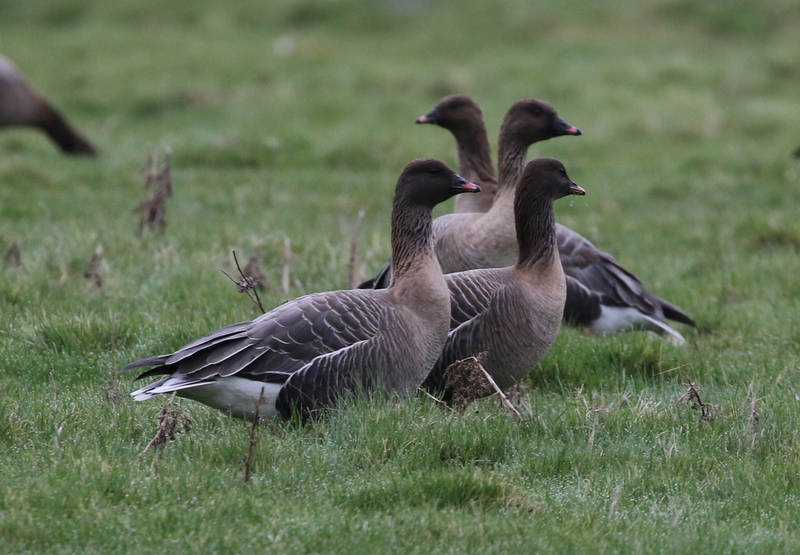 Pink-footed Geese – still a few at Holkham today
Pink-footed Geese – still a few at Holkham today
Once we had parked, we got out and scanned the fields at the north end of the Drive. There were lots of Wigeon out on the grass, plus a few Teal and Shoveler on the pools. Several Oystercatchers were piping noisily, and we could see a few Redshanks around the wetter bits. A Common Buzzard perched up on a bush.
A pair of Egyptian Geese started hissing and honking and, as we walked through the pines, another pair answered them from up in the trees. There were a few small birds on the north edge of the pines. We could hear a Goldcrest singing and saw a couple flitting around in the low bushes. A Treecreeper was singing from deeper in the trees.
As we walked along to the east end of the saltmarsh, there was a large gang of Shelduck out in the low vegetation. A Sparrowhawk circled up out of the trees. Several waders were feeding on the pools, mostly Redshank, but in with them we found a group of 10 Ringed Plover and a lone Dunlin. A Stonechat was busy feeding on the edge of the dunes. There were plenty of Skylarks but no sign of any Shorelarks in their favoured spot today. The Shorelarks had been reported further west at one point yesterday, so we decided to walk that way and try our luck.
Coming out through the dunes, we stopped to scan the sea. A single female Common Scoter was quite close inshore, but we could see a much larger raft, 80-100 strong, some way further out. In amongst the gulls on the beach, we could see several silvery white Sanderling running in and out between them. There were also more Ringed Plover on the beach and a little group of Turnstone flew past and landed on the tideline ahead of us.
There was still no sign of the Shorelarks where they had been yesterday, but we continued our way west. We were aiming for Joe Jordan Hide next, so we figured we could cut directly through the pines further along. It was a good move. As we came round a corner and could see the the high tideline stretching away in front of us, we spotted a flock of small birds some way ahead. Through the scope, we could see they were the Shorelarks.
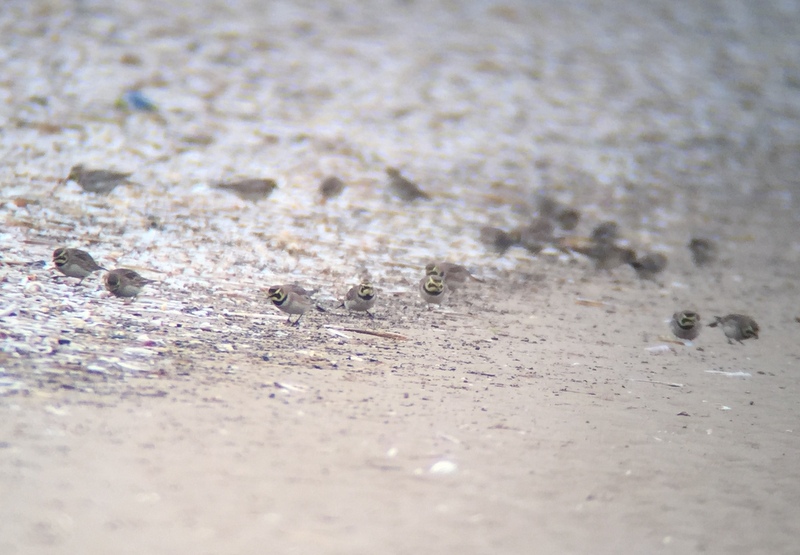 Shorelarks – some of the 32 on the beach at Holkham today
Shorelarks – some of the 32 on the beach at Holkham today
At first we could only see 14 Shorelarks but then we noticed another 18 further along. Gradually the two groups caught up with each other and merged. It was great to see all 32 Shorelarks together, a very good sized flock by the standards of recent years. We walked further up towards them, to where we could get a good look at them through the scope, admiring their bright yellow faces and black bandit masks.
After enjoying the Shorelarks for a while, we took the path up over the dunes and through the pines and emerged at the cross-tracks right by the Joe Jordan Hide. As we walked up to the steps, we could see several large white shapes on the pool out in front – Spoonbills. They were doing what Spoonbills seem to like doing most, namely sleeping! From up in the hide, we got them in the scope.
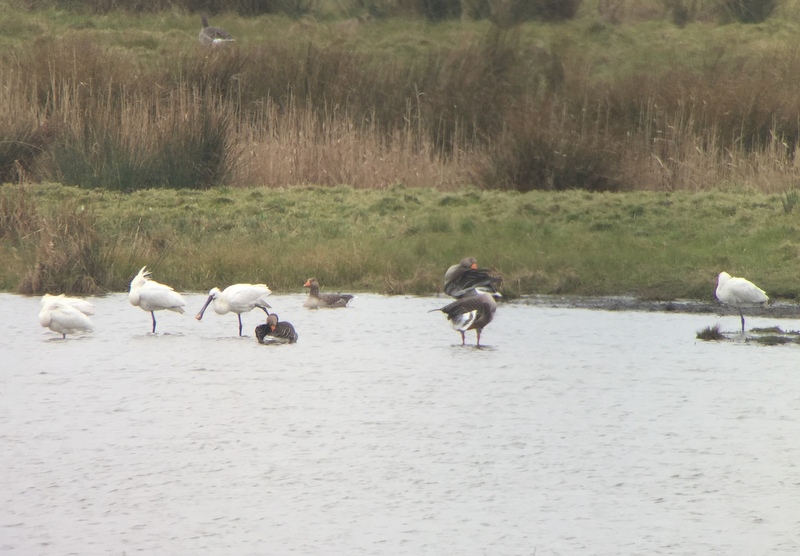 Spoonbills – these five spent most of the time asleep
Spoonbills – these five spent most of the time asleep
There seemed initially to be only four Spoonbills, but on closer inspection there were two asleep in front of each other, meaning five birds in total, one more than there has been in recent days. Occasionally, one of them would wake up briefly, have a quick stretch or a preen, and then go back to sleep. We could see the bushy nuchal crest on a couple of them blowing in the breeze and when one of them woke up, we could see the yellow tip to its blackish bill, confirming it as an adult. A juvenile Spoonbill nearby, one of last year’s brood, had no crest and, when it woke briefly, a fleshy coloured bill.
There were fourteen Avocets on the pool too. Like the Spoonbills, they are starting to return now after the winter. In contrast, a couple of Ruff out on the wet grass with the Lapwing have probably been here all winter and should be heading off north to breed in a month or two.
The other thing which immediately struck us when we got into the hide was the number of geese. They were predominantly White-fronted Geese, probably at least 500, scattered in groups all over the grass. There were several right down in front of the hide today, which meant we got a great view of them, their white blaze around the base of the bill and the adult’s with their black belly bars.
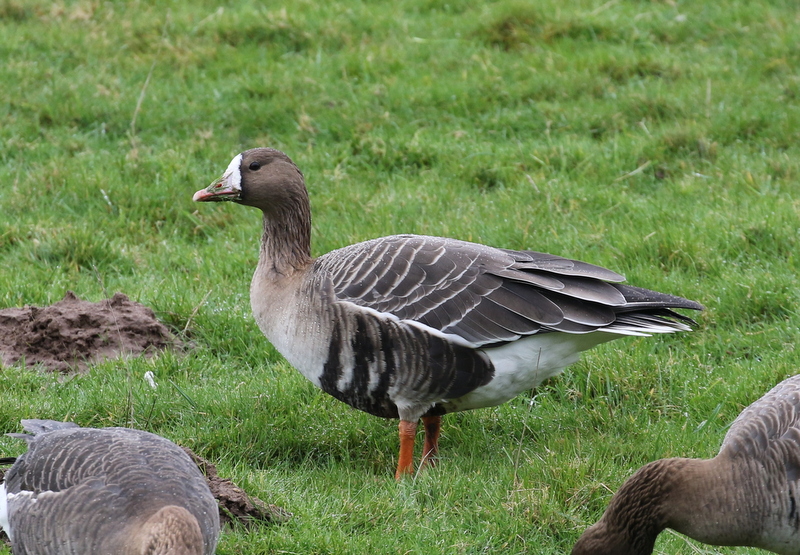 White-fronted Goose – an adult, with black belly bars
White-fronted Goose – an adult, with black belly bars
We could hear the distinctive yelping calls of the White-fronted Geese as they bickered among themselves. We talked a little about different races of these geese and the fact that the birds here are Russian White-fronted Geese. They should be off back to Russia for the breeding season soon. Looking through the flock down below us, there was a single Pink-footed Goose in with them and three Greylag Geese nearby for comparison.
Despite the light drizzle which was falling, there was still a little bit of raptor activity. Several Marsh Harriers were flying and at one point one male even started displaying. We could hear it calling first and then saw it flying with distinctive flappy wingbeats and doing some half-hearted swooping up and down.
The one bird we hadn’t seen from the hide which we might have hoped to was a Great White Egret. However, we had only gone a short distance along the path on our way back when we spotted one on the edge of a reedy ditch not far away on the grazing marsh. We got it in the scope and admired its long, yellow bill. It stretched its neck up, so we could see just how tall it was.
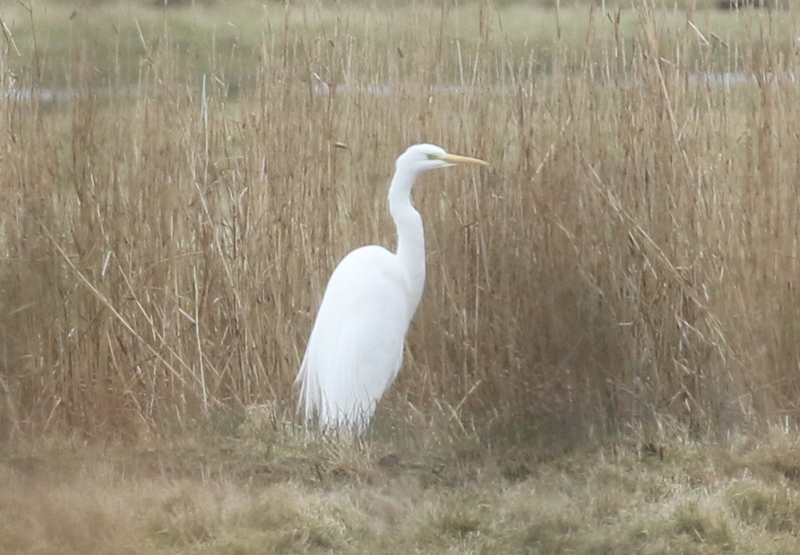 Great White Egret – on the edge of the grazing marsh on the way back
Great White Egret – on the edge of the grazing marsh on the way back
Then the Great White Egret flew. As it took off, we could see from the effort required just how big it was. It flew off east and, as we got back to Washington Hide we saw what we presumed was the same bird dropping down away from us over the reeds. The next thing we knew another Great White Egret appeared from the ground below and the two of them flew off together, back in the direction from which we had just come.
Another couple of Goldcrests were feeding with some Long-tailed Tits in a bush beside the path. A quick look at Salts Hole on our way past added Tufted Duck, Coot and Little Grebe to the day’s list. Then we headed back to the car.
There has been a Pallid Harrier in the last few days, seen occasionally in the area behind Holkham and Wells. We were heading west to Titchwell for the afternoon, so we had a quick drive round via that way. It was always going to be like looking for a needle in a haystack, and it was still drizzling, so it was perhaps no surprise that we didn’t find it. We did see a Red Kite over the fields.
It was time for lunch when we got to Titchwell. While we were eating the rain picked up a bit – it was still not heavy, but just heavier drizzle than it had been. After lunch, we set off to explore the reserve. The feeders in front of the visitor centre were fairly quiet, but there was much more activity around the ones the other side. Mostly Chaffinches, Greenfinches and Goldfinches, but we soon found a couple of Bramblings too.
Unusually, there was no sign of the Water Rail in the ditch by the path today – perhaps it was hiding from the rain? The Thornham grazing marsh ‘pool’ was exposed to the elements and consequently also quiet. We had a quick look for the Bittern in the ditch across the reedbed, but that was empty too. Three Marsh Harriers circled up at the back of the reeds. The reedbed pool was a little more productive, but the two drake Red-crested Pochard flew off just as we arrived.
Given the rain, we made our way quickly round to Parrinder Hide from where we could have a good look at the Freshmarsh. It looked rather quiet here at first, with fewer gulls and Avocets than there have been in recent days. However, as we scanned across we found a few birds and a steady succession of different things dropped in.
There was a nice little flock of Dunlin feeding feverishly around the muddy islands, occasionally swirling round and landing again somewhere nearby. A couple of larger Knot appeared nearby briefly. A Bar-tailed Godwit dropped in for a quick bathe and preen too. Most of the Black-tailed Godwits were right over the far side, but two landed with the gulls in front of the hide so we could get a good look and see the differences between the two species.
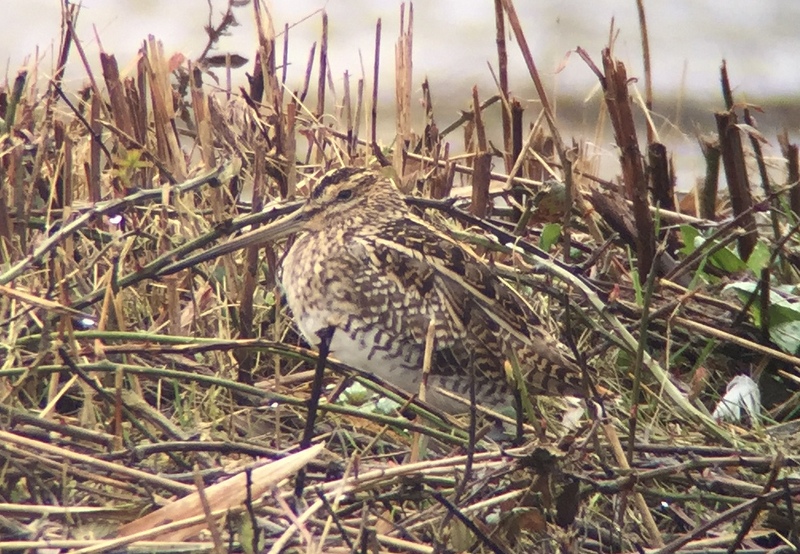 Common Snipe – one flew in and proceeded to try to hide on one of the islands
Common Snipe – one flew in and proceeded to try to hide on one of the islands
A Common Snipe flew in and landed on the mud as we arrived at the hide. When we went to have a look at it, we found it had walked up onto the middle of one of the islands and was trying to hide in the cut vegetation on top. The other wader highlight was a single Spotted Redshank which was feeding along the edge of the reeds opposite the hide. Even from a distance, it was strikingly pale, silvery grey above and white below.
The smaller number of gulls here today consisted of just Black-headed Gulls plus a few Herring Gulls. But while we were watching the waders, we heard a loud ‘keeyu’ call and looked up to see a smart adult Mediterranean Gull flying in. It landed on the edge of the other gulls but attracted the attention of a particularly aggressive Avocet which decided to chase it off. The Mediterranean Gull flew a short distance away and the Avocet went after it, before the whole process repeated itself.
Eventually the Mediterranean Gull was able to settle briefly so we could get a look at it in the scope. It was a full summer adult, with a complete and jet black hood, a bright red bill, thicker than a Black-headed Gull‘s, and distinctive pure white wingtips. However, possibly as a result of the Avocet‘s earlier aggressive pursuit, the Mediterranean Gull didn’t stay long and soon flew off back west again.
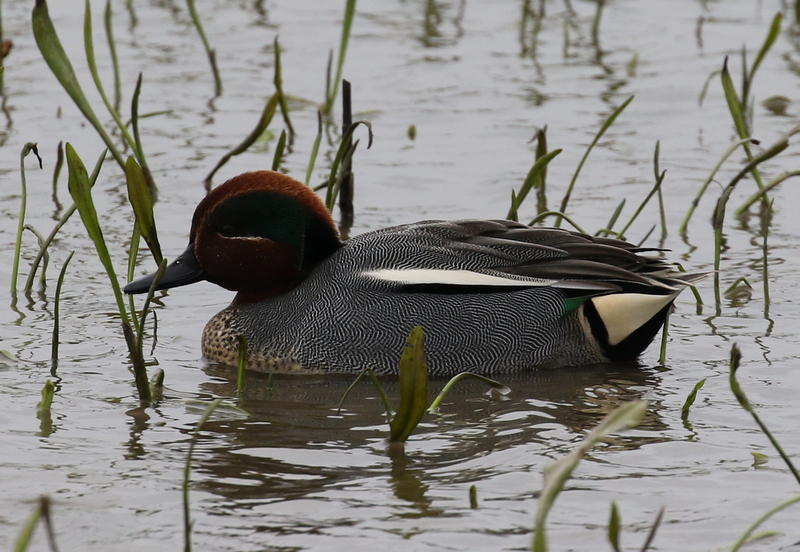 Teal – a little group of drakes were displaying today
Teal – a little group of drakes were displaying today
There were not so many ducks on here today. There are still a few Teal, though numbers appear to be dropping. A little group of drakes in front of the hide were busy chasing each other and displaying. There were also a few Gadwall and Shoveler and a little group of Wigeon over in the far corner. A pair of Red-crested Pochard dropped in briefly, over by the reeds.
As the rain had eased, we made our way across to the other side of the Parrinder Hide, to have a look at the Volunteer Marsh. There was a good selection of waders on here at first. Several Avocets were obviously preferring to feed here rather than the Freshmarsh, and were vigorously sweeping their bills back and forth over the mud in front of the hide.
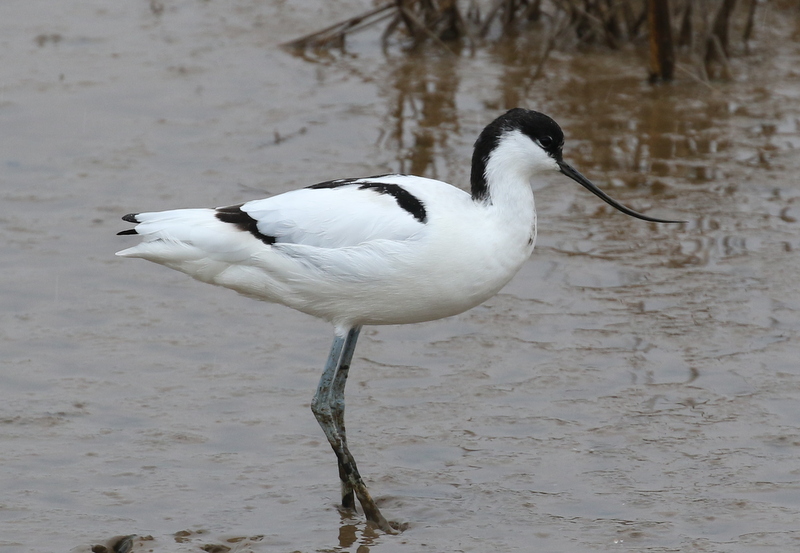 Avocet – feeding on the Volunteer Marsh today
Avocet – feeding on the Volunteer Marsh today
A smart Grey Plover was also feeding just in front of the hide. We watched it standing motionless, then stepping forward and picking at the ground, before taking another couple of quick steps and then standing still again. At one point it managed to find a large worm. There were also several Dunlin, a few Knot, a couple of Bar-tailed Godwits, plus assorted Redshank and Curlew. Then suddenly everything took off and all the waders flew towards the Freshmarsh. We scanned the sky, but couldn’t see what might have spooked them.
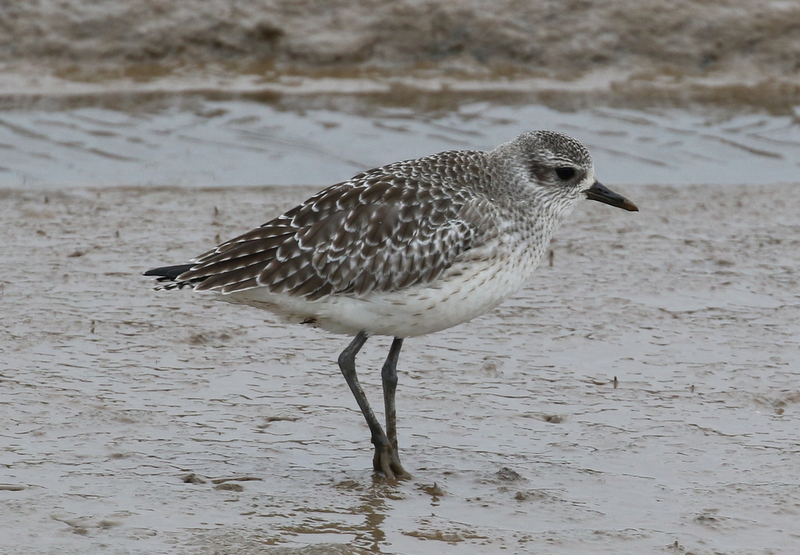 Grey Plover – feeding in front of Parrinder Hide
Grey Plover – feeding in front of Parrinder Hide
With most of the birds having flown, and the rain having eased back to a light and intermittent drizzle, we decided to make a bid for the beach. The Tidal Pools were unusually quiet today. It was just after low tide, so most of the waders were on the beach, but there were fewer ducks and no Pintail. A single Little Grebe swam across quickly and dived into cover beneath the path.
Out at the beach, the sea was still a long way out. We stood in the shelter of the dunes and scanned the water. As we arrived, we could see a large flock of ducks flying. They only went a short distance before landing again, but long enough for us to see the distinctive white wing flash on most of them – they were Velvet Scoters. There were probably around 100 still today, with just a few Common Scoter mixed in with them, and a few more Common Scoter nearby.
Otherwise, we could see several Red-breasted Merganser distantly, over in the mouth of Brancaster harbour channel. A few Great Crested Grebes were on the sea, as was a single Red-throated Diver, which we got in the scope.
The rain had stopped by the time we started to make our way back. The Pintail were out on the saltmarsh, which was why we hadn’t seen them on the Tidal Pools earlier. A pair flew in and over the bank towards the Freshmarsh, giving us a great view of the male’s long tail as they passed. Back at the Freshmarsh, a large flock of Brent Geese flew in from the east and landed on the water. A pair of Red-crested Pochard were preening on the edge of the reedbed pool.
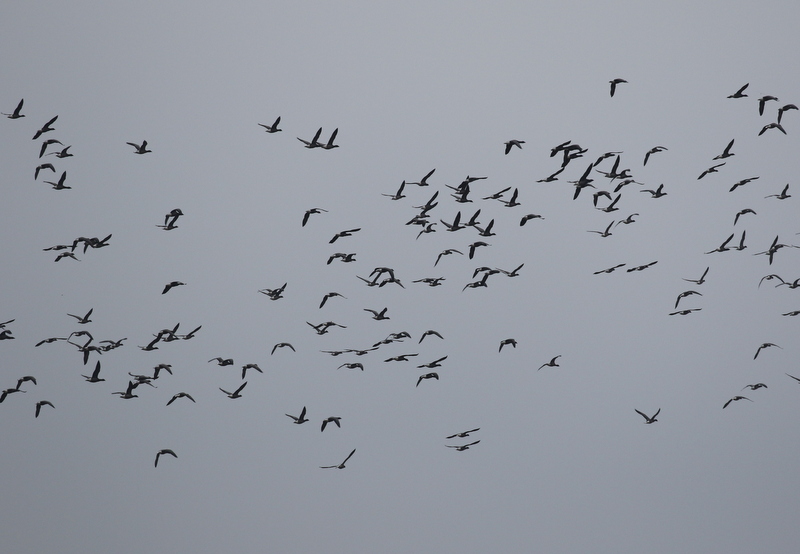 Brent Geese – a large flock flew in to the Freshmarsh
Brent Geese – a large flock flew in to the Freshmarsh
There was still no sign of the Bittern in the reedbed channel, but there were two Kingfishers perched up in the reeds either side on the way past. Then it was back to the car.
We still had enough time to swing round via the back of Holkham and Wells on our way back. The Pallid Harrier had been reported again briefly at lunchtime. As we turned off the coast road, we spotted a harrier flying low along the edge of a field. Unfortunately, it was clearly too big and broad winged, and a quick look through binoculars confirmed it was a Hen Harrier. Still a great bird to see!
We found a few people looking for the Pallid Harrier, but they confirmed it had not been seen again, so we decided to call it a day and made our way back to Wells. It had been a good day and we hadn’t even got too wet!
















